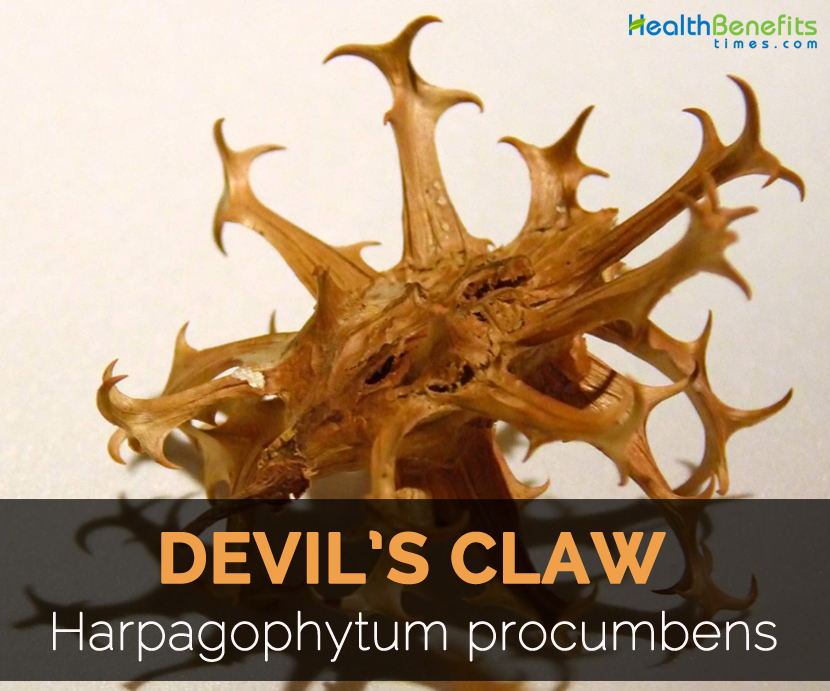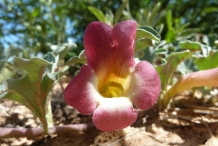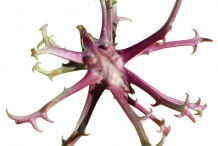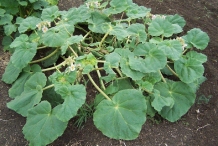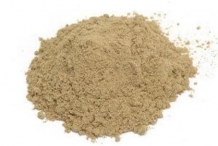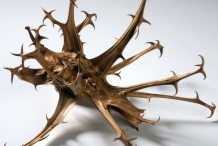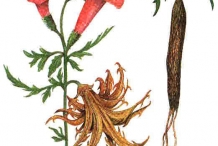History
Devil’s claw is native to Southern Africa that has got its name from tiny hooks that cover fruit. It was used for treating liver, pain, malaria, fever and kidney ailments. It has been used for curing boils, sores and other skin ailments. In the early 1900s, it was introduced to Europe where the dried roots was used for restoring appetite, lower pain, provide relief from heart burn and inflammation. In these present days, it is used widely in France and Germany as a cure for low back pain, headache, relief from arthritis pain and counteract inflammation. In 1953, it was introduced in Europe by O.H. Volk and was used for treating various metabolic diseases. In 1970, the root was considered a boom in Switzerland and Europe.
Plant
Devil’s claw is a perennial plant that bears a small and claw like fruit which has a strong and central taproot that grows upto 2 m deep. Its secondary roots are used in teas and decoctions. It has large and grey to green leaves along with red, pink or purple flowers in a trumpet shape. The flower blooms in the summer and fruits from January. Later on the flower forms a woody fruit that exhibits long and branched protuberances along with barbs. The drupaceous capsule has an inner part woody which is surrounded by a fleshy layer. The inner woody capsule splits at one end into tow curved claws or horns. About 40 black seeds are found in each capsule.
Roots
This perennial plant has branched root system as well as branched and prostate shoots of about 1-1.5 m long. From the lateral and main roots, it forms tuber roots. The main roots has upright collar like sections, quadrangular, obtuse, 30-60 cm thick and 10-20 cm long with a fissured cork layer. The lateral root have 60 mm thick nodes which is upto 20 cm long and light to brown or red to brown in color. The roots grow to the depth of about 30-60 cm.
Leaves
The opposite or alternate leaves are lobed and petiolate. The leaf blades are broadly ovate to triangular from 6.5 cm long and 5-15 cm wide.
Health benefits of Devil’s Claw
Botanically known as Harpagophytum procumbens is useful for treating fever, pain, malaria, liver and kidney problems. Topically, it is used for boils, skin problems and sores. The tubers and roots are the plant parts which are used as medicine. Though the plant is odorless, it is very bitter in taste. This plant is used to stimulate appetite, provide relief from inflammation, pain, indigestion and heart burn. Some other health benefits are:
- Treatment for obesity
Ghrelin is a derived peptide of stomach which circulates hunger hormone that provides a orexigenic effect on the activation of receptor. It treats obesity and its associated diseases. This medicinal plant possesses analgesic and anti-inflammatory properties. It is used as an appetite modulator. The root extract of Harpagophytum procumbens acts as a novel source for anti-obesity bioactives. It promotes natural bioactives to be developed in functional foods along with weight maintenance and weight loss. (1)
- Cure osteoarthritis
The evidence is limited for the treatment of hip and knee osteoarthritis with the use of Harpagophytum extract. The study was carried out on regular intake of 100 mg of Harpagophytum extract helps to treat chronic low back pain. The evidence shows that the extract of 50 mg of Harpagoside at a daily dose helps to treat acute exacerbations of chronic NSLBP. (2)
- Antimutagenic activity
Harpagoside possess antimutagenic activities against environmental mutagen or carcinogen. It promotes chromosomal damage protection as it possess natural antioxidant in extracts. It underlines interest of hydroethanolic or aqueous extracts. Still the investigations are carried out to know the relationship between antimutagenic and anti-inflammatory properties. (3)
- Provides relief from pain
The studies have shown that Devil’s claw acts as a natural alternative for pain killing medications. It shows that it is used to provide relief from pain in shoulder, lower back and neck. The treatment of regular dose of Devil’s claw for about 4 weeks provides relief from pain.
- Lower arthritis
Devil’s claw was used for arthritis which was discovered by early European colonists in Africa. The studies show that the use of Devil’s claw for two or three months has great impact on mobility and pain in arthritis patients.
- Supports digestion
It is helpful for treating various digestive problems. It is used for stimulating appetite that helps the people for maintaining digestive health which might deal with various problems such as heartburn, indigestion and stomach upsets.
- Skin health
Traditionally this plant has been used for dealing various skin complaints such as boils and sores. Apply it topically for treating bruises, minor wounds and scrapes. It calms joint and muscular inflammation as well as pain associated with gout and arthritis.
Traditional uses
- It is used to cure skin disorder and injuries.
- Its root provides relief from pain, arthritis, pregnancy discomforts, kidney, metabolic disorders, liver and bladder issues.
- It is useful for arthritis, rheumatism, stomach disorders and inflammation.
- It slows down loss of bone and useful for people with osteoarthritis of knee or hip and rheumatic disorders.
- Intake 600 mg of Devil’s claw extract with food for two times in a day.
- Massage with ointments and gels to a minor joint pain twice in a day.
Precautions
- Not to be used for prolonged period and more than recommended amounts.
- It should be avoided by the pregnant and lactation women.
- It may cause dyspepsia, gastrointestinal bleeding and ulcers.
- It may interact with supplements, other herbs and medications.
- The excessive use of Devil’s claw causes mild stomach problems.
- Not recommended for the people having duodenal ulcers, stomach ulcers and gallstones.
- It also results in gastrointestinal side effects.
- Consult the doctor for use of Devil’s claw by the people with high blood pressure, heart disease and low blood pressure.
- It raises the chances of bleeding if already taken blood thinners such as warfarin, aspirin and clopidogrel.
- With diabetic medications, it increases the chances of low blood sugar.
- Vomiting, nausea, headaches, abdominal pain, loss of appetite, ringing in ears and loss of taste are other side effects.
- It might causes menstrual problems, allergic skin reactions and change in blood pressure.
- It increases the bile production so it is not preferred to the people having gallstones.
- Devil’s claw increases stomach acid production that is harmful for patients of stomach ulcers.
References:
http://www.theplantlist.org/tpl1.1/record/kew-2839701
http://davesgarden.com/guides/pf/go/96690/
https://www.mskcc.org/cancer-care/integrative-medicine/herbs/devil-claw
http://www.umm.edu/health/medical/altmed/herb/devils-claw
https://medlineplus.gov/druginfo/natural/984.html
http://www.avogel.ch/en/plant-encyclopaedia/harpagophytum_procumbens.php
https://en.wikipedia.org/wiki/Harpagophytum
http://waynesword.palomar.edu/ww0801.htm
https://plants.usda.gov/plantguide/pdf/cs_prpa2.pdf
http://powo.science.kew.org/taxon/urn:lsid:ipni.org:names:675824-1
https://healthyfocus.org/benefits-of-devils-claw/
Comments
| Devil’s Claw Quick Facts | |
|---|---|
| Name: | Devil’s Claw |
| Scientific Name: | Harpagophytum procumbens |
| Origin | It was originated in South Africa and Namibia and spread to Kalahari and Savannas. |
| Taste | Bitter |
| Health benefits | Treatment for obesity, Cure osteoarthritis, Antimutagenic activity, Provides relief from pain, Lower arthritis |
| Name | Devil’s Claw |
|---|---|
| Scientific Name | Harpagophytum procumbens |
| Native | It was originated in South Africa and Namibia and spread to Kalahari and Savannas. |
| Common/English Name | Devil’s Claw Root Tuber, Devil’s Claw Secondary Root, Kalahari devil’s claw, Grapple plant, Harpago, Wood Spider, Grapple vine, xwate, Radix Harpagophyti |
| Name in Other Languages | Finnish: Harpagojuuri; |
| Plant Growth Habit | Perennial |
| Root | Branched root system |
| Leaf | Petiolate, lobed, opposite or alternate |
| Flower | Large, solitary, pale-pink to crimson |
| Root Taste | Bitter |
| Plant parts used | Dried tubular secondary roots, thick lateral tubers |
| Seed capsules | Bivalvular, compressed, ovate, 6 cm in diameter, 7 to 20 cm long |
| Seed shape and size | Oblong |


